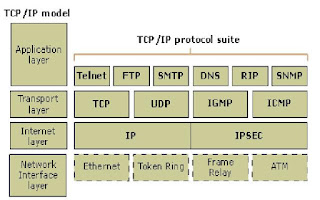Transmission Control Protocol
TCP
(Transmission Control Protocol)
TCP is a set of rule (protocol) used along with the Internet protocol (IP) to send data in the form of message units between computers over the Internet. While IP takes care of handling the actual delivery of the data, TCP takes care of keeping track the individual units of data (called packets) that a message is divided into for efficient routing through the Internet.
For example, when an HTML file is sent to you from a web server, the Transmission Control Protocol (TCP) layer in that server divides the file into one or more packets, numbers the packets, and then forwards them individually to the IP program layer. Although each packet has the same destination IP address, it may get routed differently through the network. TCP is known as connection-oriented protocol, which means that a connection is established and maintain until the message or message to be exchanged. TCP is responsible for ensuring that a message is divided into the packets that IP manages and for reassembling the packets back into the complete message at other end. In the open systems Interconnection (OSI) communication model, TCP is in layer 4, the Transport layer.



Comments